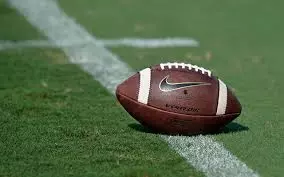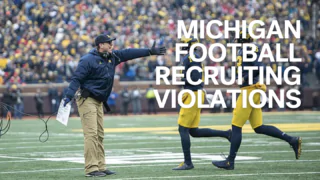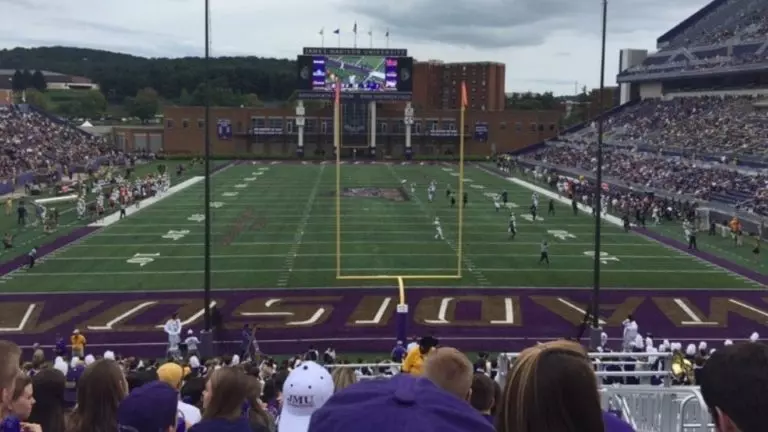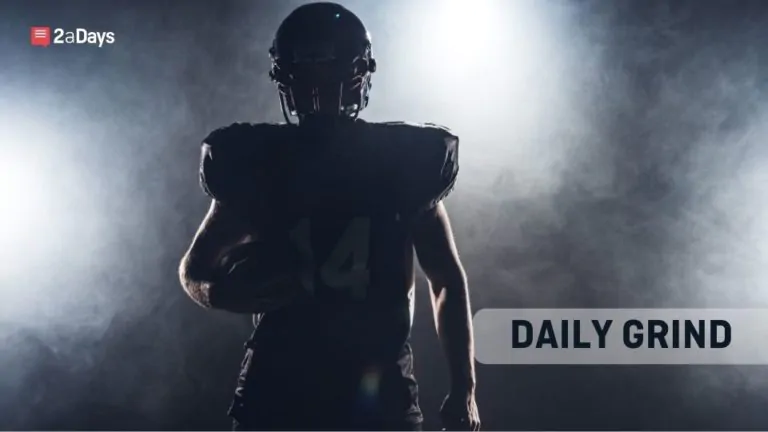College football recruiting is different from many other sports because of how massive the sport is. There is a big difference between NCAA Power Five recruiting and Division II and III recruiting because of budgets and resources.
There are two primary ways an athlete gets recruited: game film and camps. Game film, or sometimes a live visit from the coach, is the only time they can see a player at full effort and strength. Camps are great ways to show speed and strength through measurable drills like the 40-yard dash or vertical jump. Every rep, set, inch, and hit matters in games and camps because of the competition for one of the coveted spots on the football team.
Highlight tapes should show high football IQ, strength, and the best qualities of the athlete. Likewise, it is important to practice the 40-yard dash, bench press, and 5-10-5 agility drills to perfect form to get the best scores during combines and camps. These qualities, along with height and weight, are tracked by coaches to measure an athlete's size and speed. A combination of the measurables with game film shows coaches the type of player a prospect is, and players good in both will be recruited by football coaches.
Not every athlete will be able to play college football, just 9.4% will play college football, and 3% will play Division I. There are 11:1 odds that a football player right now will make a college football roster, regardless of division. Athletes must also consider the possibility of a scholarship and understand the number of scholarships allotted per team.
In This Guide
- Football Recruiting Fast Facts
- Understanding College Football Divisions
- What Matters to Play College Football?
- Showcases and Camps
- Contacting Coaches
- Example Email
College Football Recruiting Fast Facts
| Total College Football Athletes |
|---|
| 97,159 |
| Average College Roster Size |
|---|
| 110.9 |
| Total Revenue |
|---|
| $6.5 B |
Source: U.S. Department of Education Equality in Athletics Data Analysis
Football Recruiting Statistics
- 1,023,908 athletes play high school football.
- 9.5% of those high school athletes go on to play college football.
- 3.1% of high school athletes go on to play Division I football.
Source: ScholarshipStats.com
Understanding the Different Divisions for College Football

When starting the football recruiting process, athletes should keep in mind that there are different recruiting processes for different divisions. Football players need to understand each division's guidelines, rules, and deadlines before committing to a division or school.
NCAA Division I FBS
There are two subdivisions within Division I football. FBS stands for Football Bowl Subdivision. The main difference between the two subdivisions is the level of competition and resources. FBS schools typically have a higher level of competition, are larger, and have more money and resources than FCS schools. FBS schools are also able to offer 85 scholarships and usually have extremely competitive recruiting classes. If you end up at an FBS school, you will have way more resources around you, a strong coaching staff, and incredible athletes as teammates, but you may struggle more to find playing time on the field.
Coaches can send recruiting materials and make contact with prospects as early as September 1 of the player's junior year in high school (keep in mind: athletes can reach out to coaches and verbally commit before their junior year).
NCAA Division I FCS
The second subdivision in Division I is the FCS, the Football Championship Subdivision. FCS schools will typically be smaller, less competitive, and have fewer resources than FBS schools. FCS schools are only allowed 63 scholarships, but they can be divided into partial scholarships. This subdivision will still have a very high level of football, and it will be easier to get playing time on one of those rosters.
NCAA Division II
NCAA Division II schools are smaller schools with smaller budgets. Division II schools can also offer scholarships, but it is much more rare to receive a full scholarship. Scholarship money can be paired with academic money. Division II coaches can contact prospects and send recruiting materials starting June 15 after the player's sophomore year. Official visits can also occur after June 15 the summer of after player's sophomore year.
NCAA Division III
The biggest difference in NCAA Division III is that DIII schools cannot offer athletic scholarships. DIII schools can offer academic scholarships and/or financial aid, but you will need to verify with each individual school. However, with these options, athletes can sometimes end up paying less than DII or DI. There are no date restrictions to initiating contact with a coach and you can go on an official visit after January 1st of your junior year.
NCAA Requirements
- If you are planning on playing NCAA Division I or Division II, you MUST register with the NCAA Eligibility Center. The NCAA will review your academic standing and they will make sure that you have only competed at amateur levels in your sport (meaning you have not received payment for playing your sport). Division III athletes do not need to register.
- SAT/ACT scores are NOT required for the NCAA. You will only have to report your scores to your school if they require test scores.
NAIA

The National Association of Intercollegiate Athletics (NAIA) has two divisions. It is a smaller association with around 300 schools.
NAIA schools can offer more playing time for players, don't require as many hours of dedication as NCAA DII and DI, and don't have as much traveling for games. The NAIA can offer 24 athletic scholarships to football players.
JUCO

The National Junior College Athletic Association (NJCAA or JUCO) are all 2-year schools. The NJCAA has around 525 member schools with three divisions.
JUCO schools are a great option for athletes who want to refine their skills before transferring to a four-year school. It can also be a good choice If you need to get your grades up to qualify for a four-year school or if you started the recruiting process later than you wanted.
What Matters Most to Play Football in College?
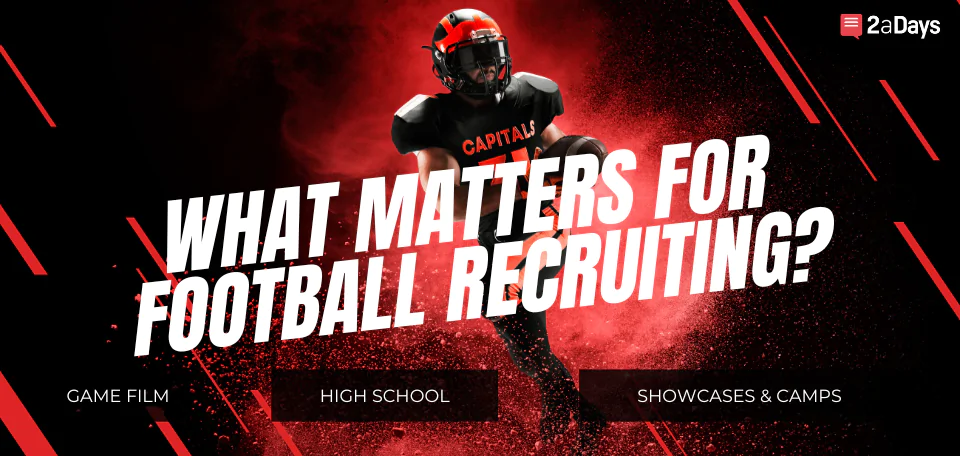
Football is unlike recruiting in other sports because other sports have more opportunities to play other than high school. Most opportunities to play football are through high school football teams, except for the few club teams that exist. Football is such a physically intensive game so the summers and off-season are focused on recruiting or working out.
The closest a player can get to playing live football outside of their high school is playing on a 7v7 team. 7v7 teams are well-liked for practice and competition throughout the offseason. Players can hone their talents and compete on these teams in a setting that is less physically taxing than full-contact sports. Being a member of a successful 7v7 squad can show players they have key football abilities including reading defenses, making rapid decisions, and throwing or catching the ball accurately.
However, A player's effectiveness in full-contact sports, physical characteristics, and character traits like work ethic, leadership potential, and coachability are all factors that coaches and recruiters take into consideration. They might also take into account a player's academic standing and extracurricular activities. Another downside to 7v7 leagues is that not everyone can play. The linemen are not able to play these leagues because they are too physically intense for non-padded football.
Public high schools mostly compete against other schools in the state but private schools can play whatever team they want. Private schools can also recruit kids from any district, unlike public schools. Private schools will have an edge against public school teams because of funding. They can fund their program and recruit players from farther places. High school football players do not have to attend one of the best high schools for a chance to get recruited. College coaches search everywhere to find talent they can recruit to their football team.
A player that is unhappy with their high school program and their chances to play at the next level have the opportunity to transfer schools. The rules governing high school transfers differ based on the state and school district, so athletes and their families should become acquainted with these guidelines. In some situations, moving institutions may cause a student to sit out a season or lose postseason eligibility. Transferring to a new high school does not ensure that a player will have more exposure to college coaches or increase their chances of being recruited in terms of opportunities for playing college football. Coaches at colleges frequently judge players on their own merits rather than the accomplishments of their high school teams, so they may still be able to assess a player even if they represent a less successful high school program.
Showcases and Camps

Undoubtedly, showcases and camps are crucial for landing a college football scholarship. High school football players can use these occasions to demonstrate their abilities, athleticism, and potential in front of college coaches and recruiters. For players who live in areas where there are not very many places to play, attending camps and showcases can be extremely beneficial. These events give players the chance to test their skills against other top athletes and connect with college coaches who are always looking for new players.
Some of the showcases and camps are organized by the colleges themselves, allowing players to see the coaching staff and the college football program firsthand. This is a great way to get noticed by the coaching staff and demonstrate an interest in a certain program. Remember, the process of attending football showcases and camps is only one part of the football recruiting process for a college athlete. The coaches also base their evaluations on character, academic records, high school performance, and game film. All the same, showcases and camps can be an effective tool for starting the recruiting process and getting on a coach's radar.
The country has numerous football camps and showcases, and it is tough to choose the very best ones because it depends on how much the athlete is attempting to accomplish.
Players have to be cautious about shelling out their money on camps and combines. To maximize their investment, they need to take into consideration their personal objectives, the reputation of the camp, the price, and possible advantages. If you would like to find out if a camp is worth attending, examine its history and check out reviews. It is also crucial that recruits think about what they would like to gain from attending a combine or camp. Some are aiming to be noticed by college coaches, while other people might be working hard on enhancing their skills. It's important that the event aligns with these goals.
It is also vital that you assess the price of the camp or combine it along with other expenses such as transportation as well as lodging, to avoid wasting money. Not only can attending too many events be expensive, but it might not offer you any extra advantages. Recruits increase their chances of being successful by being intentional and strategic about the camps or combines they participate in, as well as saving money.
A few of the more prestigious as well as exclusive camps and showcases, though, are invitation-only events, to which only a limited number of players are invited. These invitation-only events are usually reserved for the best high school football players in the nation and tend to be attended by college coaches and NFL scouts. They permit these top players to compete against one another and demonstrate their abilities to the best coaches in football. There are a lot of top-notch camps and showcases that are open to all players and also could supply you with good chances to get noticed by college coaches as well as improve your game. These events are usually organized by respected organizations as well as colleges or football programs. The player has to conduct research and select events that are consistent with their goals and provide them with the greatest chance of success.
Best Football Camps:
The Rivals Combine Series has multiple locations across the United States. This camp will focus on getting your stats up to impress coaches.
- Admission is free for this camp
2. Under Armour All-America Camp Series
The Under Armour Next All-America camp occurs in Orlando, Florida, and is a week-long experience for hand-picked athletes. This camp has tons of big-time coaches in attendance and has great resources.
- Invitation-only: all expenses are paid
The Elite 11 Quarterback Camp has various locations across the country and is for the best high school quarterbacks in the country. Campers will get to learn from some of the best quarterback coaches in the nation.
- Cost: $799
The Elite 100 Exposure Camps also have multiple locations throughout the country. They are one-day camps that offer tons of testing, drills, and scrimmaging.
- Cost: $125
The Manning Passing Academy occurs in Thibodaux, Louisiana, and is for quarterbacks, running backs, wide receivers, and tight ends. This is a three-day camp where you can learn from some of the best of the best.
- Cost: $900 for overnight campers, $650 for day-only campers
Contacting Coaches
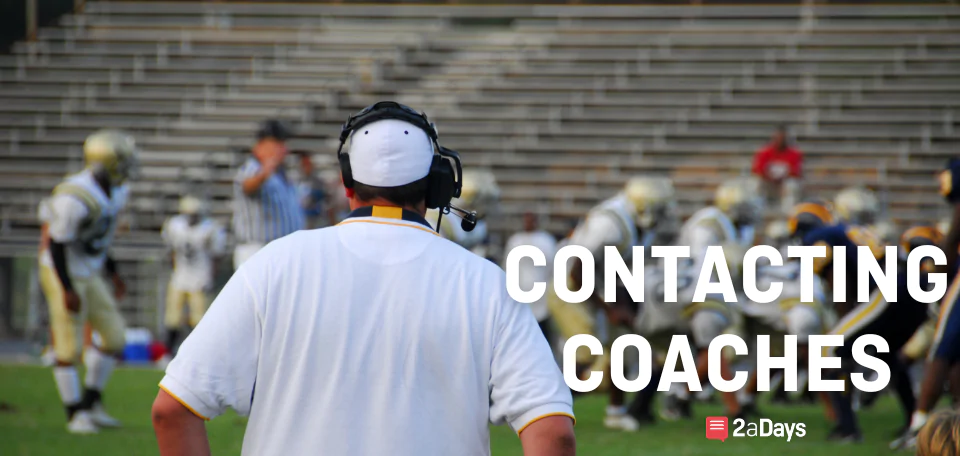
There are important steps to take when contacting a college football coach:
- The very first thing you have to do is research the schools and coaches which you're interested in. This can help the student make certain the program is in line with their objectives and values.
- The next step is to produce a football recruiting profile for the student which contains information regarding their athletic and academic accomplishments, along with their contact info. This will allow it to be simple for coaches to help keep in contact with the students as well as find out about their achievements.
- Students can create a profile and send out an email to the coaches they're interested in.
- The email needs to be short, professional, and contain a link to the student's recruitment profile.
- When the coach is responsive, students must follow up and continue to show an interest in the program in a timely fashion.
- Students may even be noticed by the coaching staff by going to camps or exhibitions organized by their respective schools. Students will maximize their odds of being recruited if they're persistent, professional, and proactive in their outreach.
Division I football programs usually have a recruiting coordinator who is in charge of the recruitment efforts. Certain coaches are a lot more involved in the recruitment process than the others:
- The head coach is involved in the recruitment and has the ultimate say in who gets offered a spot on the team.
- Position coaches also play a crucial role in the recruitment process because they are in charge of evaluating and choosing players for their positions. They can be responsible for communicating with recruits, assessing their skills, and also giving feedback on their perspective fit within the program.
- Defensive and offensive coordinators can also play a part in the recruitment process since they are responsible for creating and implementing game plans and may want to attract players that fit their schemes.
The recruitment process is, in the end, a team effort with a variety of coaches and staff members working in concert to identify, evaluate, and recruit the ideal players for their program.
What should I include in my email to college coaches?

Recruits should send out emails to three coaches: the head coach, the position coach, and the recruiting coach. This gives you the best chance for someone to see your film.
Here is an example of an email for a football coach:
Subject: [Name], [Class Year], [Position], [Key Stats], [Video Attached]
Dear Coach [Last Name],
My name is [Your Name] and I am in the graduating class of [year] at [Your High School] in [Hometown, State]. I am writing this email because I am highly interested in [Name of the College] and learning more about your program.
[Put a small paragraph here discussing any research that you did on the school, highlighting what you are interested in, and specific qualities that they have that you think stand out, maybe points on how you like how the team plays/the coaching style/philosophy and relating to how you think you would fit in academically and athletically.]
I play [list the position you play] and I am ___ height and ___ weight. Some of my accomplishments are [list your top three to four individual awards, championship/tournament wins, or recognitions]. You can view my complete playing resume here [Link to your playing resume or online profile]. I have also attached a highlight of my respective games. Please feel free to contact my coach(es):
[include the email and phone number of your coach(es)]
Thank you for your time and consideration. I look forward to hearing from you soon.
Sincerely,
[Your Name]
[Add attachment or link to an online highlight video]
[Include your email, phone number, and address at the bottom]
Final Thoughts
The football recruiting process can be stressful and confusing. However, if you put yourself out there, take advantage of every opportunity, and follow the information above, you will end up in the right place. Don't be afraid to talk to current and former college football players about their process and ask them what you can do best to succeed.


